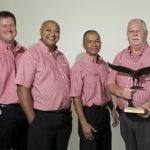Full Electrification for Volvo Bus?

FRANK BEETON reports that Volvo Bus is to start full production of hybrid-electric buses in 2016, and on the progress of India’s urban bus fleet renewal programme.
Back in 2013, we reported on Volvo Bus moving beyond hybrid drivelines to the “plug-in” system, where battery recharging could take place independently of the normal hybrid’s internal combustion engine. By then, the concept of hybrid and alternative driveline buses had already gained considerable momentum.
Field tests of the new plug-in hybrid system commenced in Volvo’s home town of Gothenburg, Sweden, during May 2013, using three test buses equipped with roof-mounted collector gear.
The parallel hybrid system, carried over from the original Volvo Hybrid design, made it possible for the bus to operate exclusively on electric power at lower speeds, and progressively bring in the on-board, four-cylinder diesel engine at higher speeds, or for recharging the batteries.
Subsequently, the Volvo Group announced that it was also studying inductive charging technology, where the vehicle draws current from under the road surface, and that it was developing a proposal to construct a 300 to 500 m electric road to test the concept – also in its home town of Gothenburg, during 2015.
The proposed programme was to include the building of a section of road equipped with wireless charging technology, and to provide vehicles which use on-board batteries to receive the available charge while passing over the enabled section of “electric road”. It has subsequently been announced that one of the stops on this proposed ElectriCity emission-free route is to be placed inside a building.
Late last year, Volvo Bus signed a global partnership agreement with ABB Technologies of Switzerland to secure the supply of standard-based e-bus fast chargers for electric-hybrid and full-electric buses. The associated automatic connection system will be located in the bus roof, and will connect with the fast charger at selected charging stops.
The first joint project to be executed under this agreement will involve the operation, from 2015, of 12 Volvo Electric Hybrid buses by Sales-Lentz in Luxembourg. This operator was the first European user of Volvo Hybrid buses in 2009, and has clearly embraced electric buses as its intended direction for the future.
Volvo Buses, in turn, has indicated that it has sold almost 1 600 hybrid buses to date, and is moving towards increased electrification of its products, to provide society with full electro-mobility. To this end, it launched its 7900 Electric Hybrid bus at last year’s IAA show in Hannover, thus industrialising the plug-in technology that had previously proved to be successful in the 2013 Gothenburg test.
This model differs from the earlier 7900 Hybrid low-floor bus in that it has a larger battery package, and a collector installed in the roof. Battery charging is carried out at route termini, and can be completed in six to ten minutes. Volvo claims that noise levels of its Electric Hybrid (at some 65 decibels), is similar to normal conversation levels. Series production is due to commence in early 2016.
India’s urban bus fleet renewal
In December 2005, the Indian government launched the Jawaharlal Nehru National Urban Renewal Mission (JNNURM), as a wide-ranging programme intended, through a process of modernisation, to improve the quality of life and infrastructure in the country’s major cities.
The initial phase ran until March 31, 2014. It has subsequently been followed by JNNURM-II, which was initially planned to commence in the 2013/14 fiscal year, but was deferred to the 2015/16 budget period to accommodate the Indian general election.
Part of the scheme involves the acquisition of large numbers of new city buses by state transport undertakings. This has resulted in the placing of substantial orders on India’s two major domestic bus manufacturers; Ashok Leyland and Tata Motors.
The Ashok Leyland share of the business is made up of some 4 000 buses at a value reportedly equivalent to €190 million (R2,53 billion).
The vehicles to be supplied are a mix of JanBus, JanBus Midi and Viking SLF models, which are being delivered to 22 state transport undertakings including: Calcutta State Transport Corporation; Bangalore Metropolitan Transport Corporation; Andra Pradesh State Road Transport Corporation; Jaipur City Transport; and Pune Mahanagar Parivahan Mahamandal Limited.
Readers may recall that we reported on the launch of the 12-m JanBus and eight-metre JanBus Midi models in mid-2014, and noted that they provided a slightly different perspective on front-engined bus design.
In pursuing a single-step entry and constant low floor height of 650 mm, Ashok Leyland had opted for a completely built-up configuration, employing integral, chassisless construction. This eliminated the cranked chassis frame that was traditionally used for low-floor bus designs and the associated capacity-robbing longitudinal seats over front and rear axles. The JanBus models are built at Ashok Leyland plants in Ennore and Bhandara.
The Tata Motors portion of the business consists of more than 2 700 city buses, of a type specifically designed for the JNNURM programme. They are equipped with locally-built 6,7-litre Cummins ISBe engines, driving through Tata six-speed overdrive manual transmissions, or alternatively, an Allison full-automatic.
The bodies feature an extra-wide passenger entrance, 400 mm floor height, front suspension kneeling function, closed-circuit television cameras, and an automated system that announces details of routes, stops and adjacent services. These buses are being built at joint venture Tata Marcopolo’s Dharwad and Lucknow facilities.
Published by
Focus on Transport
focusmagsa





 !
Starting 1 April, every
!
Starting 1 April, every


 FUSO: Driving the Future of Mobile Healthc
FUSO: Driving the Future of Mobile Healthc



 A brand
A brand




 Wondering about the maximum legal load for a
Wondering about the maximum legal load for a 
 The MAN hTGX powered by a hydrogen combus
The MAN hTGX powered by a hydrogen combus


 Exciting News for South African Operators
Exciting News for South African Operators



